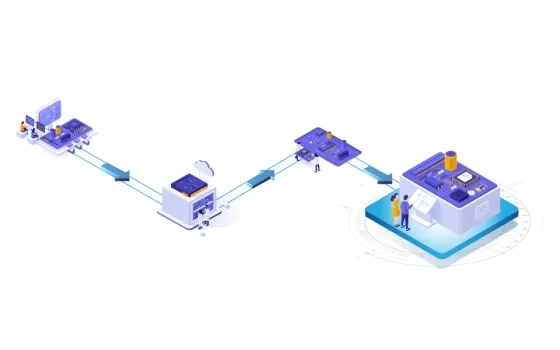Often referred to as microchips or integrated circuits (ICs), semiconductors are one of the greatest marvels of modern technology. Today, over 100 billion semiconductors are used around the world every day.
In this four-part, multi-author blog series, we will embark on a journey to understand more about this seminal technology, its present successes, and the future possibilities for unprecedented progress.
Semiconductors- The Building Blocks of Modern Electronics
Semiconductors have not only made modern gadgets a reality, but constant advancements in the industry have made these devices smaller, cheaper, more powerful, and easily accessible to the public. For instance, in 1984, cellular phones weighed almost 2lbs., were priced at 4,000 USD, and could only hold a charge sufficient for talking for 30 minutes at a stretch. Today’s smartphones, including foldables, have taken a gigantic leap in terms of design and communication capabilities since then.
Semiconductors will play a key role in future technological advancements, as they are the foundation of technologies like 5G, AI, digital manufacturing, and medical technology. By 2025, the number of IoT (Internet of Things) devices installed worldwide will likely surpass 74 billion. By 2030, this number is projected to reach 125 billion. The more abundant these devices become, the more semiconductor technology becomes prevalent which, at this point, is a foregone conclusion.
It is no surprise that the semiconductor industry is projected to witness immense growth in the near future. A Gartner report expects the industry to grow by 7.4% in 2022 worldwide. Another report by McKinsey predicts that the industry will witness constant growth throughout this decade and emerge as a trillion-dollar industry in 2030.
The Technology Behind Semiconductors- The Four Main Verticals
Semiconductor processing operates on mainly four verticals, namely:
- Very Large-Scale Software Integration (VLSI)
- System Design
- Platform Software
- Validation
In a nutshell, VLSI refers to the process through which millions of transistors are merged and integrated into a single semiconductor chip. Moving on, hardware system design comprises the process of designing compact, agile, and energy-efficient ICs to cater to market demand. When we talk about platform software as a component, we specifically mean an innovative platform software solution. Such a solution needs to enable semiconductor companies to manufacture superior quality products with a high degree of design success with more competitive pricing. Finally, validation is the vertical in which a semiconductor chip is tested in a lab setup to validate different aspects of functional correctness.
In this first part of the series, VLSI takes the spotlight.
The Significance of VLSI- Use Cases and Major Advantages
Very large-scale integration is the technology that allows an IC designer to incorporate many peripherals like CPU, RAM, and ROM into a single chip. It is the process of developing an IC by combining millions of transistors into a solitary chip.
The technology first came to the forefront in the 1970s, when communication technologies and complex semiconductors were first being developed. With time, electronic devices have become increasingly handy, portable, and accessible, and the incredible development in this industry over the last five decades can be credited to advancements in VLSI technology. Simply put, VLSI can be regarded as the backbone of the semiconductor industry.
Presently, cellular communications, and devices like smartphones, leverage this technology to provide unmatched portability, application access, and processing capabilities. Portable electronic appliances like laptops, smartphones, and devices using automated applications like refrigerators, air conditioners, and washing machines, are a few of the real-time applications of VLSI. VLSI circuits are used in all electronic equipment, for example, microprocessors in a computer, chips in a digital camera or graphic card, and embedded processors in automobiles.
The key advantages offered by VLSI technology are:
- Unparalleled reduction in circuit size
- Enhanced cost-effectiveness for gadgets
- Faster circuit operating speed
- Lower power requirements than distinct components
- High device dependability
- Less requirement of space and promotion of miniaturization
System Design: One of the Four Pillars of Semiconductor Technology
System design is an essential component of semiconductor development. From the data center to the network edge, current and emerging applications necessitate high-performance and high-efficiency hardware implementations. Creating a comprehensive and integrated system design process aids in the identification of appropriate solutions and remedies to potential challenges.
In the semiconductor paradigm, system design encompasses the following functional areas:
- Hardware platform design
- Radio frequency design
- Mechanical design
- Testing and validation
- Platform software design
- Field programmable gate array (FPGA) design and validation
Across the above areas, the primary goal of system design is to ensure optimal processing across the creation and testing of chips.
Platform Software and Middleware: The Smart Behind the Smart
Semiconductor chipsets have massively evolved in the last five decades. An enormous amount of software has been linked to the latest semiconductor chips in some form or other. Platform software and middleware take the lead in this regard owing to their ability to produce error and defect-free solutions for end customers. They ensure that algorithms and functionalities work the way they were designed to, also playing a crucial role in simulating the end-customer use case and customer workloads to the greatest extent possible. During the final phase of the semiconductor designing process, what we commonly call ‘shift-left’, this helps engineers identify the key gaps and address shortcomings, even before the chips are manufactured. Having insight into which variables are most important to chip performance, evaluating, comparing, and optimizing alternative designs becomes cost and time efficient.
Consequently, the semiconductor fabrication software market is growing and is projected to reach USD 6.6 billion by 2027. The shift from planar field effect transistor designs to fin-shaped field effect transistor (FinFET) architecture design is one of the key drivers of this promising growth. In addition, emerging technologies like the Internet of Things (IoT) and feature upgradation of digital cameras, tablets, smartphones, computers, and more are also fueling the demand for semiconductor fabrication software.
The Final Step in a Fruitful Odyssey: Validation
we have understood every process that goes into the making of a semiconductor integrated circuit (IC). In order to understand what validation entails, we need the added context of these processes. This is because, over the course of the process leading up to validation, semiconductor manufacturers spend a sizeable amount of expenses creating new components as part of the overall design. With so many complex tasks happening at a minuscule level, it is imperative that the IC functions fully and properly under all possible conditions and use cases as desired by the end user(s). This is validation.
Under various environments across several manufacturing units in enterprises, the number or nomenclature of the steps involved in validation can vary. For instance, verification often happens throughout the semiconductor process where the design is tested against a given design specification to ensure functional correctness. Testing is also conducted at the manufacturing and/or production phase to check for random defects, faults, and reliability. It is sometimes either considered as a part of validation or as separate from it, occurring after the validation is done.
Validation often includes two phases— Pre-silicon and post-silicon validation. Pre-silicon validation happens before the IC is available, in a virtual environment with advanced tools for simulation, emulation, and formal verification. Post-silicon validation happens on the actual IC and its containing devices in real-world environments via commercial system boards as well as logic analyzer and assertion-based tools. This simulates real-world use and helps expose any potential flaws before product release.
The semiconductor industry is at the forefront of ushering in the greatest era of technological advancement. It has systemically revolutionized communication, entertainment, travel, work, and the treatment of illnesses, to name just a few key areas of our lives. With semiconductors projected to transform entire industries, from medicine and energy to consumer electronics and aerospace, we are yet to experience its full potential. Through constant innovation, the semiconductor industry will continue to steer economic growth, create employment, and develop technologies required to build a future of limitless possibilities.



















